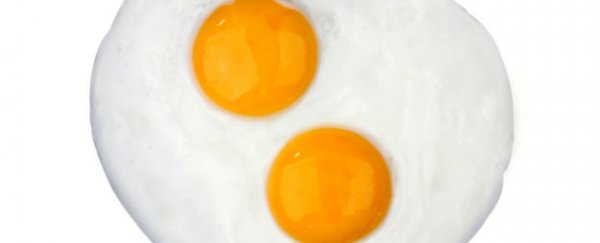At a time when we're finally starting to realise that there's actually no scientific evidence to suggest that eating egg yolks will heighten your risk of developing heart disease, comes the rise of the double-yolk egg. Produced by the third-generation family farm, Saunder's, these 'Double Yolkers' have been sold to locals in Pennsylvania for years, but with heightened demand, the unusual product will be shipped around the US by the dozen.
Double-yolk eggs occur when ovulation progresses quicker than normal, or when one yolk gets 'lost' and is accidentally linked up with another yolk. They're usually the result of a hen's reproductive cycle not yet being synchronised, or 'settled in', which is more common in younger hens.
According to Hugh Merwin at Grub Street, double-yolk eggs occur naturally at a rate of roughly one in 1,000 eggs. While chickens that are more likely to produce double-yolk eggs are selectively bred elsewhere in the world, at Saunder's, the process is all about playing the numbers.
"Chickens that are first put into a chicken house are more likely to lay double-yolkers," a quality-control representative at Saunders told Merwin, adding that these new hens will also likely lay slighter larger eggs than their more seasoned peers. From experience, they also know that at around 22 to 23 weeks old, hens are likely to produce a slightly higher than average number of eggs.
Working with their young hens, the Saunder's farmers have to identify each double-yolker manually, by hand. "Every egg, double or not, is inspected with a light ('candling' is the official term) to look for blood spots and egg development," says Chris Mills at Gizmodo. "But that also enables inspectors to differentiate on the number of yolks, and the doubles are set aside and packaged at Sauder's into its Double-Yolker packages."
Strangely enough, there's even an app in development to detect double-yolkers in the carton. It works by 'hacking' your phone to cause it to emit ultrasound pulses through the built-in speakers, which enables it to reconstruct the internal structure of the egg:
Sources: Grub Steet, Gizmodo
